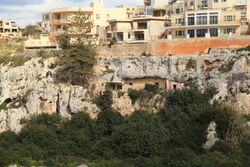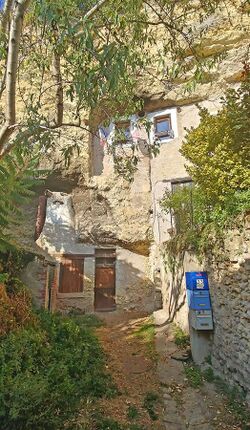Cave dweller
Topic: Earth
 From HandWiki - Reading time: 5 min
From HandWiki - Reading time: 5 min
A cave dweller, or troglodyte, is a human being who inhabits a cave or the area beneath the overhanging rocks of a cliff.
Prehistory
Some prehistoric humans were cave dwellers, but most were not (see Homo and Human evolution). Such early cave dwellers, and other prehistoric peoples, are also called cave men (the term also refers to the stereotypical "caveman" stock character type from fiction and popular culture). Despite the name, only a small portion of humanity has ever dwelt in caves: caves are rare across most of the world; most caves are dark, cold, and damp; and other cave inhabitants, such as bears and cave bears, cave lions, and cave hyenas, often made caves inhospitable for people.
The Grotte du Vallonnet, a cave in the French Riviera, was used by people approximately one million years ago. Although stone tools and the remains of eaten animals have been found in the cave, there is no indication that people dwelt in it.
Since about 750,000 years ago, the Zhoukoudian cave system, in Beijing, China, has been inhabited by various species of human being, including Peking Man (Homo erectus pekinensis) and modern humans (Homo sapiens).
Starting about 170,000 years ago, some Homo sapiens lived in some cave systems in what is now South Africa, such as Pinnacle Point and Diepkloof Rock Shelter. Caves were the ideal place to shelter from the midday sun in the equatorial regions
. The stable temperatures of caves provided a cool habitat in summers and a warm, dry shelter in the winter. Remains of grass bedding have been found in nearby Border Cave.[1]
Approximately 100,000 years ago, some Neanderthal humans dwelt in caves in Europe and western Asia. Caves there also were inhabited by some Cro-Magnons from about 35,000 years ago until approximately 8,000 BC. Both species built shelters, including tents, at the mouths of caves and used the caves’ dark interiors for ceremonies. The Cro-Magnon people also made representational paintings on cave walls.[2]
Also about 100,000 years ago, some Homo sapiens worked in Blombos Cave, in what became South Africa. They made the earliest paint workshop now known, but apparently did not dwell in the caves.[3]
Writers of the classical Greek and Roman period made several allusions to cave-dwelling tribes in different parts of the world. For details, see Troglodytae.[4]
Historical
In Hirbet Tawani near Yatta Village in the Southern Hebron Hills in an area contested between the Palestinian Authority and Israel there are Palestinians who have lived in caves who have been recorded to be doing so during The British Mandate for Palestine and before, under the Ottoman Empire. In recent years some have been evicted by the Israeli government or by settlers.[5]
Especially during war and other times of strife, relatively small groups of people have lived temporarily in caves, where they have hidden or otherwise sought refuge. They also have used caves for clandestine and other special purposes while living elsewhere.
Perhaps fleeing the violence of Ancient Romans, people left the Dead Sea Scrolls in eleven caves near Qumran, in what is now an area of the West Bank managed by Israel's Qumran National Park. The documents remained undisturbed there for approximately 2,000 years, until their discovery in the 1940s and 1950s.
The DeSoto Caverns, in what became Alabama in the United States, were a burial ground for local tribes; the same caves became a violent speakeasy in the 1920s. The Caves of St. Louis may have been a hiding-place along the Underground Railroad.
From about 1000 to about 1300, some Pueblo people lived in villages that they built beneath cliffs in what is now the Southwestern United States.
In her book Home Life in Colonial Days, Alice Morse Earle wrote of some of the first European settlers in New England, New York, and Pennsylvania living in cave dwellings, also known as "smoaky homes":
In Pennsylvania caves were used by newcomers as homes for a long time, certainly half a century. They generally were formed by digging into the ground about four feet in depth on the banks or low cliffs near the river front. The walls were then built up of sods or earth laid on poles or brush; thus half only of the chamber was really under ground. If dug into a side hill, the earth formed at least two walls. The roofs were layers of tree limbs covered over with sod, or bark, or rushes and bark. The chimneys were laid of cobblestone or sticks of wood mortared with clay and grass. The settlers were thankful even for these poor shelters, and declared that they found them comfortable. By 1685 many families were still living in caves in Pennsylvania, for the Governor's Council then ordered the caves to be destroyed and filled in.[6]
In the 1970s, several members of the Tasaday apparently inhabited caves near Cotabato, in the Philippines .
Caves at Sacromonte, near Granada, Spain, are home to about 3,000 Gitano people, whose dwellings range from single rooms to caves of nearly 200 rooms, along with churches, schools, and stores in the caves.
Some families have built modern homes (or renovated older ones) in caves, as in Missouri;[7] Matera, Italy;[8][9] and Spain.[10]
At least 30,000,000 people in China live in cave homes, called yaodongs; because they are warm in the winter and cool in the summer, some people find caves more desirable than concrete homes in the city.[11]
In the Australian mining towns of Coober Pedy and Lightning Ridge, many families have carved homes into the underground opal mines, to escape the burning desert heat.
In the Loire Valley, abandoned caves are being privately renovated as affordable housing.[12]
In the UK, the rock houses at Kinver Edge were inhabited until the mid-20th century.[13]
See also
- Caveman
- Cave monastery
- Cave painting
References
- ↑ Wadley, Lyn; Esteban, Irene; de la Peña1, Paloma; Wojcieszak1, Marine (2020). "Fire and grass-bedding construction 200 thousand years ago at Border Cave, South Africa". Science 369 (6505): 863–866. doi:10.1126/science.abc7239. PMID 32792402. https://hal.archives-ouvertes.fr/hal-02998410/file/Wadley_galley_UncorrectedProofBedding.pdf.
- ↑ Butzer, Karl W. (1983). "Cave dwellers". World Book Encyclopedia. 3. Chicago: World Book, Inc.. p. 245.
- ↑ Wilford, John Noble (13 October 2011). "In African Cave, Signs of an Ancient Paint Factory". The New York Times. https://www.nytimes.com/2011/10/14/science/14paint.html?hpw=&pagewanted=all.
- ↑ Chisholm, Hugh, ed (1911). "Troglodytes". Encyclopædia Britannica. 27 (11th ed.). Cambridge University Press. pp. 298–299.
- ↑ Cave dwellers defy Israeli eviction bid, September 24, 2004 (The Guardian website)
- ↑ Earle, Alice Morse, ' 'Home Life in Colonial Days' ', Ch. 1, pp.2-3.
- ↑ "Really Extreme Makeover". n.d.. https://www.nytimes.com/slideshow/2010/03/21/realestate/keymagazine/20100321-reuse-slideshow_9.html.
- ↑ Guiffrida, Angela (18 June 2017). "The miracle of Matera: from city of poverty and squalor to hip hub for cave-dwellers". The Guardian. https://www.theguardian.com/world/2017/jun/17/matera-italy-culture-capital-cave-homes-from-squalor-to-airbnb-film-sets.
- ↑ Perrottet, Tony (February 2014). "How Matera Went From Ancient Civilization to Slum to a Hidden Gem". Smithsonian. https://www.smithsonianmag.com/travel/mater-went-from-ancient-civilization-slum-hidden-gem-180949445/. Retrieved 3 June 2020.
- ↑ Lewine, Edward (2 October 2008). "Cave Living? Cool!". New York Times. https://www.nytimes.com/2008/10/05/realestate/keymagazine/105hscave-t.html.
- ↑ Demick, Barbara (18 March 2012). "In China, millions make themselves at home in caves". https://www.latimes.com/news/nationworld/world/la-fg-china-caves-20120318,0,2352472.story.
- ↑ Malone, Luke (22 July 2014). "This Converted Cave in France Cost $1.35". Vocativ. http://www.vocativ.com/culture/society/cave-houses/.
- ↑ "Restored Kinver Rock House opens". BBC. 2 March 2012. https://www.bbc.com/news/uk-england-stoke-staffordshire-17208140.
External links
 Ernest Ingersoll (1920). "Cave-Dwellers". Encyclopedia Americana.
Ernest Ingersoll (1920). "Cave-Dwellers". Encyclopedia Americana.
 KSF
KSF


